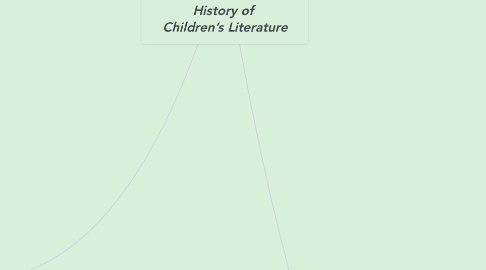
1. 18th – 19th Century
1.1. Books of Instruction and Information
1.1.1. The contents were about the education of children.
1.1.2. Samuel G. Goodrich: biography and information about sciences, history, etc.
1.1.3. Maria Edgeworth: The Purple Jar (Famous short story)
1.2. The rise of legend folktale collections
1.2.1. Brothers Grimm: Children’s and Household Tales
1.2.2. Hans Christian Anderson: The Fairy Tales
1.2.3. Sir George Webbe Dasent: Popular Tales From the Norse
1.2.4. Joel Chandler Harris: Uncle Remus, His Songs and His Saying
1.3. Fictions for Children
1.3.1. Alice’s Adventures in Wonderland by Chales Lutwidge Dodgson.
1.3.2. Pinocchio by Carlo Collodi
1.3.3. The Adventure of Tom Sawyer by Mark Twain
1.3.4. Little Women by Luisa May Alcott
1.3.5. The Jungle Books by Rudyard Kipling
1.4. Magazine
1.4.1. a magazine named ‘Charm’ which was the first true children’s magazine for English Children.
1.4.2. the famous and popular children’s magazines were ‘The Juvenile Miscellany’ and ‘St.Nicolas’.
1.5. Illustrators of children’s literatures
1.5.1. George Cruikshank
1.5.2. Sir John Tenniel
1.5.3. Randolph Caldecott
1.6. Charles Monroe Schulz: The Peanut Comic Strip
2. 20th Century – the Present
2.1. Fantasy stories and realistic fiction have been popular.
2.1.1. Winnie-the-Pooh (1926) by A. A. Milne (U.K.)
2.1.2. Little House in the Big Woods (1932) by Laura Ingalls Wilder (U.S.)
2.1.3. The Hobbit (1937) by J. R. R. Tolkien (U.K.)
2.1.4. The Little Prince (1943) by Antoine de SaintExupery (France)
2.1.5. The Lion, the Witch and the Wardrobe (1950) byC.S. Lewis (U.K.)
2.1.6. Charlotte’s Web (1952) by E. B. White (U.S.)
2.1.7. A Wrinkle in Time (1962) by Madeleine L’Engle(U.S.)
2.1.8. Harry Potter and the Sorcerer’s Stone (1998)by J. K. Rowling (U.K.)
2.2. Numerous children’s book awards were established.
2.2.1. - In the U.S.,
2.2.1.1. Newbery Medal (began in 1922): the most distinguished children’s book published
2.2.1.2. Caldecott Medal (began in 1938): the mostdistinguished children's picture book published
2.2.2. In the U.K.,
2.2.2.1. Carnegie Medal (began in 1936): the most distinguished children's book published
2.2.2.2. Kate Greenaway Medal (began in 1956): themost distinguished children's picture book published
3. Riddles and puzzles children had to solve were written in Latin.
4. Early Beginnings
4.1. Aldhelm (640-709 A.D.)the first man to write lesson books for children.
4.1.1. set the pattern for all books of instruction from that time up to 1500 A.D.
4.1.2. All books used question and answer form and were written in verse.
4.2. The Venerable Bede (673-735 A.D.) was a teacher at a monastery school.
4.2.1. showed more imagination.
4.2.2. spark of learning in the Dark Ages.
4.2.3. They contained all the knowledge then known of natural science, natural history, and the study of plants and flowers and stars.
4.3. Egbert of York (766 A.D.)
4.3.1. collected the works of the previousmonks and books by outstanding Greek and Roman
4.3.2. wrote a variety of lesson books, still using question and answer
4.3.3. Wrote many books on grammar
4.3.4. Tutored sons and daughters of the household at the court
4.3.5. This is also one of the earliest records of co-education.
4.4. The Middle English Period
4.4.1. In 1066, William the Conqueror and his Norman French knights invaded and won England.
4.4.2. French words were introduced into English because it was the language of the nobility.
4.4.3. This period lasted until the invention of the printing press by Gutenberg
4.4.4. Children of nobility continued to receive instruction in manners and morals
4.5. Anselm (1034-1109 A.D.)
4.5.1. theArchbishop of Canterbury, wrote the first encyclopedia for children.
5. 14th – 17th Century
5.1. Renaissance comes from the French words
5.2. The first book published was “The Bible
5.3. The Creator of the first English printer was ‘William Caxton’.
5.3.1. first publication was ‘Aesop’s Fables’ in 1484.
5.3.2. printed in Latin and English in 1585
5.4. The creation of Hornbook and Battledore
5.4.1. Books were too expensive to be used by children, so the Hornbook was created for them
5.4.2. alphabets and numbers were published for children in the battledores version
5.5. Puritan Times
5.5.1. England and America, children’s books were rather gloomy.
5.5.2. which was one that was more interested in the fear of God than in the love of life.
5.5.3. Famous Works
5.5.3.1. Obis Pictus by John Amos Comenius
5.5.3.2. Milk for Babes by John Cotton
5.5.3.3. The New England Primer by Harris
5.5.3.4. The Token for Children, Being an Exact Account of Conversation. Holy and Exemplary Lives and Joyful Deaths of Several Young Children by James Janeway
5.5.3.5. Pilgrim’s Progress by John Bunyan (The best book in Puritan Times)
5.5.3.6. The Life and Strange Surprising Adventure of Robinson Crusoe by Daniel Defoe
5.5.3.7. Gulliver’s Travels by Jonathan Swift
5.6. The chapbook
5.6.1. It was sold by peddlers for pennies
5.6.2. It was used to read for pleasure.
5.6.3. It was forerunner of comic books
5.6.4. It was considered vulgar and corruptive.
5.7. Theory of John Locke
5.7.1. John Locke believed in ‘Tubula Rasa
5.7.2. Children developed in response to nurturing
5.7.3. was the Forerunner of behaviorism
5.8. Charles Perrault’s Fairy Stories
5.8.1. was a Frenchman published a collection of tales entitled
5.8.2. famous works were The Sleeping Beauty, Little Red Riding Hood, Cinderella, Little Thumb.
5.9. The Books of John Newbery
5.9.1. a writer and publisher who first thought publishing books solely for children.
5.9.2. “Father of Children’s Literature"
5.10. The embodied philosophy named ‘Emile
5.10.1. Jean Jacques Rousseau was a french philosopher who started a new philosophy
5.10.2. She wrote ‘Emile’ that children be given freedom to develop
